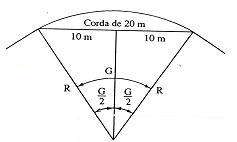Questões Militares
Para sargento da aeronáutica
Foram encontradas 11.677 questões
Resolva questões gratuitamente!
Junte-se a mais de 4 milhões de concurseiros!
Indique a alternativa que completa corretamente a lacuna da assertiva a seguir.
A _______________ das curvas de nível de um mapa é a distância vertical entre duas curvas de nível sucessivas.
Marque F (falso) ou V (verdadeiro) para o que se afirma sobre as possíveis causas dos erros naturais presentes nas medições por instrumentos medidores eletrônicos de distância (MEDs). A seguir indique a opção com a sequência correta.
( ) Proximidade com linhas de energia de alta voltagem deve sempre que possível ser evitada por topógrafos que usam aparelhos de microondas.
( ) Neve, neblina e poeira afetam o fator de visibilidade dos MEDs.
( ) Variação de temperatura, variação de pressão e erro de centragem do equipamento são erros naturais.
Indique a opção que completa corretamente a lacuna da assertiva a seguir.
Os levantamentos de _______________ ordem normalmente são utilizados para levantamentos de controle local, pequenos projetos de engenharia, mapas topográficos de pequena escala e levantamentos de limites.
Marque F (falso) ou V (verdadeiro) para o que se afirma. A seguir, indique a opção com a sequência correta.
( ) Uma cota é uma linha imaginária que conecta pontos de mesma linha.
( ) A equidistância de uma curva de nível é determinada pela finalidade do mapa e pelo teodolito usado.
( ) Colo ou sela são termos usados para descrever a área entre as curvas de nível que mostram dois cumes vizinhos e espaçados.
( ) Sombreamento é um método antigo usado para mostrar cotas relativas em mapas.
Indique a alternativa que completa, respectivamente, as lacunas da assertiva a seguir, que trata das características das curvas de nível.
Para inclinações íngremes, as curvas de nível ficarão ___________ umas das outras, enquanto para áreas relativamente planas elas serão bastante __________.
Indique a alternativa que completa corretamente a lacuna da assertiva a seguir:
O(A) _________________ pode ser formado(a) por dois planos, mas é comum ter uma forma circular ou parabólica e serve para fornecer drenagem adequada a superfície do pavimento.
Calcule o desenvolvimento (L) de uma curva horizontal a partir dos dados e da figura abaixo. Em seguida, assinale a alternativa que contém a resposta correta.
Dados:
Ângulo central (I) = 60°
Raio (R) = 150m
Considere π = 3,14

Dada a curva horizontal, calcule o Raio de Curvatura (R), sabendo-se que G é igual a 90°. Em seguida, assinale a alternativa correta.

Marque F (falso) ou V (verdadeiro) e assinale a alternativa que contém a sequência correta.
( ) A finalidade do nivelamento de perfil é fornecer as informações necessárias para desenhar as cotas do terreno ao longo do percurso proposto.
( ) Perfil é a interseção gráfica de um plano horizontal, ao longo da diretriz em questão com a superfície da terra.
( ) Seções transversais são perfis longos paralelos ao eixo do projeto.
Marque F (falso) ou V (verdadeiro) e assinale a alternativa que contém a sequência correta.
( ) O nivelamento geométrico não é utilizado pelos topógrafos.
( ) No nivelamento trigonométrico é possível determinar cotas de pontos inacessíveis como, por exemplo, picos de montanhas.
( ) Quando determinado ponto de superfície tem como referência o nível do mar tal ponto é denominado altitude.
( ) Para uma grande parte dos serviços de topografia é racional a utilização de alguns pontos convenientes como referência ou datum, com relação aos quais as cotas de outros pontos podem ser determinadas.
Calcule, em metros, o valor da cota do ponto 2 de acordo com os dados abaixo e depois assinale a alternativa correta.
Dados :
Cota do ponto 1 = 150,00m.
Altura do instrumento estacionado no ponto 1 = 1,650m
Distância horizontal reduzida do ponto 1 para o ponto 2 = 80,00 m
Ângulo vertical (lido com o aparelho estacionado no ponto 1 visando para a mira que encontra-se no ponto 2) = 01° 10’ 00’’
Leitura da mira no ponto 2 = 1,752m
Considere:
m = metro
Tangente 01° 10’ 00” = 0,02
Cosseno 01° 10’ 00’’ = 0,99
Observação: O aparelho topográfico encontra-se estacionado no
ponto 1 visando para o ponto 2.
Marque F (falso) ou V (verdadeiro) em relação aos componentes ou partes que compõem as estações totais. A seguir, indique a opção com a sequência correta.
( ) O prumo óptico é um dispositivo que permite ao topógrafo centrar acuradamente o instrumento sobre um dado ponto.
( ) Os ângulos e distâncias medidas são introduzidos no microprocessador interno.
( ) As pernas do tripé podem ser construídas de madeira ou metal.